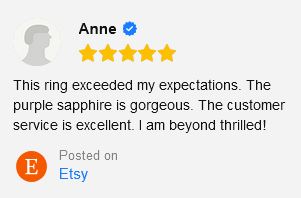|
Become an Insider & receive
up to 25% off!
|
 |
|
|
- -
|
Tanzanite RingsWith their mesmerizing bluish-purple glow, our tanzanite rings make a lasting impression. These striking designs highlight the stone's unique color and rarity in elegant, artistic ways.This page is pre-sorted from low to high price
|

 |
| 0.72 ctw Stackable Oval 4 stone Tanzanite Ring in 14k yellow gold |
In Stock GR-7024$709 |
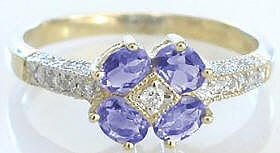
 |
| 0.91 ctw Flower Design tanzanite diamond ring in 14k yellow gold |
In Stock GR-7018$1119 |

 |
| 0.62 ctw Oval Tanzanite and Diamond Ring in 14k yellow gold |
In Stock GR-7074$1199 |

 |
| 1.23 ctw Tanzanite and White Sapphire Ring with engraved band in 14k white gold |
Ships in 2-3 weeks GR-7075-WS$1269 |

 |
| 1.24 ctw Tanzanite and White Sapphire Ring with engraved band in 14k yellow gold |
Ships in 2-3 weeks GR-7080-WS$1269 |

 |
| 1.07 ctw Tanzanite and Diamond Ring with engraved band in 14k yellow gold |
Ships in 2-3 weeks GR-7080$1759 |

 |
| 1.07 ctw Tanzanite and Diamond Ring with engraved band in 14k white gold |
Ships in 1-3 weeks GR-7075$1759 |

|
| 1.58 ctw Round Tanzanite and Pear White Sapphire Ring in 14k Yellow gold |
In Stock GR-7087$2059 |
| Customer Testimonial more... |
My beautiful tanzanite and diamond ring is the best gift I ever bought for myself! It is so elegant and stylish. I receive compliments on it every single time that I wear it...which is often! Thank you for offering such wonderful products. I love shopping with you! D.B., Pleasant Hill, CA |

|
| 1.58 ctw Round Tanzanite and Pear White Sapphire Ring in 14k white gold |
Ships in 2-3 weeks GR-7086$2059 |

 |
| 1.25 ctw Princess Cut Tanzanite and White Sapphire Ring in 14k white gold |
Ships in 1-3 weeks GR-7091$2229 |

 |
| 1.20 ctw Trillion Tanzanite and Diamond Ring in 14k white gold |
Ships in 2-3 weeks GR-7096$2129 Special Order |

 |
| 2.16 ctw Round Tanzanite and Diamond Ring in 14k white gold |
Ships in 2-3 weeks GR-7077$2649 |

 |
| 2.18 ctw Emerald Cut Tanzanite and Diamond Ring in 14k white gold |
Ships in 2-3 weeks GR-7097$2619 Special Order |

 |
| 1.39 ctw Princess Cut Tanzanite and Diamond Ring in 14k white gold |
Ships in 2-3 weeks GR-7090$2749 Special Order |

 |
| 1.32 ctw Tanzanite and Diamond Ring in 14k white gold |
Ships in 2-3 weeks GR-7069$2739 Special Order |

 |
| 2.03 ctw Oval Tanzanite and Diamond Ring in 14k white gold |
In Stock GR-7068$3029 |

 |
| 1.81 ctw Round Tanzanite and Diamond Ring in 14k white gold |
In Stock GR-7049$3179 |

 |
| 1.77 ctw Tanzanite, Pink Sapphire and Diamond Ring in 14k white gold |
Ships in 1-3 weeks GR-7089$3429 |

 |
| 3.19 ctw Round Tanzanite and Diamond Halo Ring in 14k white gold |
In Stock GR-7076$3909 |
  |
| 3.88 ctw Marquise Shape Tanzanite and Diamond Ring in 14k white gold |
In Stock GR-7073$3969 |
  |
| 2.00 ctw Tanzanite and Diamond Ring in 14k white gold |
Ships in 2-4 weeks GR-7059$4189 Special Order |
  |
| 2.70 ctw Cushion Tanzanite and Diamond Ring in 14k white gold |
Ships in 2-3 weeks GR-7092$4299 Special Order |
  |
| 2.70 ctw Cushion Tanzanite and Diamond Ring in 14k yellow gold |
Ships in 2-3 weeks GR-7093$4299 Special Order |
  |
| 2.26 ctw Tanzanite and Diamond Ring in 18k rose gold |
In Stock GR-7099$4499 |
  |
| 3.34 ctw Round Tanzanite and Diamond Halo Ring in 14k white gold |
| GR-7082 $4349 Special Order |
 |
| 2.25 ctw Cushion Cut Tanzanite and Baguette Diamond Ring in 14k white gold |
Ships in 2-3 weeks GR-7062$4349 Special Order |
  |
| 2.4 ctw Round Tanzanite and Diamond Ring in 14k white gold |
Ships in 1-3 weeks GR-7057$4609 Special Order |
  |
| 2.71 ctw Oval Tanzanite and Diamond Ring in 14k white gold |
Ships in 2-3 weeks GR-7065$4809 Special Order
|
 |
| 2.76 ctw Cushion Cut Tanzanite and Baguette Diamond Ring in 14k white gold with matching band |
Ships in 2-3 weeks GR-7098$5079 Special Order |
  |
| 2.51 ctw Tanzanite and Diamond Ring in 14k white and yellow gold |
In Stock GR-7071$5339 |
  |
| 3.74 ctw Round Tanzanite and Diamond Halo Ring in 14k white gold |
Ships in 2-3 weeks GR-7078$6519 Special Order |
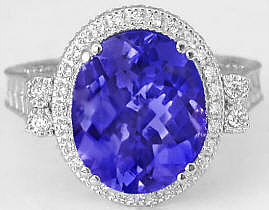  |
| 6.08 ctw Tanzanite and Diamond Halo Ring in 14k white gold |
Ships in 1-3 weeks GR-7084$7059 |
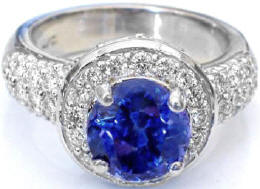  |
| 3.05 ctw Round Tanzanite and Pave Diamond Ring in 18k white gold |
Ships in 2-3 weeks GR-7052$7689 Special Order |
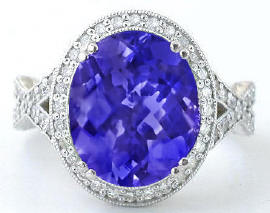  |
| 6.28 ctw Tanzanite and Diamond Halo Ring in 14k white gold |
Ships in 4-6 weeks GR-7085$7929 Special Order |
| Fun Fact: Tanzanite is also steeped in spiritual significance, with many believing that its deep, hypnotic colors can enhance intuition and foster spiritual growth. Often associated with the Third Eye and Crown chakras, this gemstone is thought to promote clarity of thought and inner peace, making it a cherished talisman for spiritual seekers. Its metaphysical properties add another layer of appeal, as many wear tanzanite not just for its beauty but also for the calming, transformative energy it is said to impart. |
Tanzanite In the NewsThe latest developments in the world of gemstones and jewelry Last Update: July 28, 2025Tanzanite Stone Buying Guide & Our Favorite Tanzanite RingsSummary: The article serves as a buying guide for tanzanite stones, highlighting their unique qualities and factors to consider when purchasing. It also features a selection of favorite tanzanite rings, showcasing different designs and styles for enthusiasts and professionals looking to add this rare gemstone to their collection.
Read More (opens in new window)
|
Tanzanitein the News
Tanzanite In the News
The latest developments in the world of gemstones and jewelry
Last Update: July 28, 2025Tanzanite Stone Buying Guide & Our Favorite Tanzanite Rings
What gives tanzanite its blue-violet color? Why do some tanzanites look more blue, and others more purple?
Tanzanites striking blue-violet color is caused by the presence of trace amounts of vanadium within the mineral zoisite. When this vanadium-bearing zoisite is exposed to heateither naturally in the earth or through gentle heating after miningthe stones color shifts to the vivid shades of blue and violet that make tanzanite so sought after. This heat treatment is standard and widely accepted in the gemstone industry, and it is both permanent and stable.
Tanzanite is also pleochroic, meaning it displays different colors when viewed from different angles. In its natural crystal form, tanzanite can show blue, violet, or even burgundy and pink tones depending on the direction of light and how the gem is oriented. Skilled gem cutters play a major role in determining whether a tanzanite appears more blue or more violet. Because tanzanite is pleochroic, showing different colors from different angles, the cutter must carefully orient the rough material to bring out the most desirable hue. By adjusting the cutting angle and table orientation, they can highlight either the blue or the violet axis of the crystal. Cutting to emphasize the blue often results in more weight loss, since the rough may naturally favor the violet direction. For this reason, blue-dominant tanzanites are rarer and more valuable, and they are more likely to be found in larger sizes. This interplay of natural crystal structure and skilled cutting is part of what makes each tanzanite so distinctive.
The final color can also be influenced by carat weight and lighting conditions. Smaller stones often show more violet, while larger gems can display deeper blues. In natural daylight, the blue tones tend to dominate, whereas warm indoor lighting brings out more of the purple. This play of color adds to tanzanites unique charm and is one of the reasons it's considered a modern classic in fine jewelry.
Is tanzanite natural or treated?
Most of the tanzanite on the market today is natural, meaning it formed in the earth over millions of years, but nearly all of it has been heat treated to achieve its beautiful blue violet color. In its untreated state, tanzanite often shows more brown, yellow, or greenish tones. Gentle heating is used to remove these less desirable colors and bring out the vibrant blue and violet hues that tanzanite is known for. This treatment is standard, widely accepted in the industry, and considered permanent and stable.
The process works by altering the oxidation state of vanadium, a trace element within the crystal lattice. Heating causes electrons to be removed from vanadium, which changes how the crystal absorbs and reflects light. This shift in the atomic structure intensifies the gems color without affecting its chemical makeup or damaging the stone itself. In simple terms, the treatment enhances what nature already created, revealing the gem's most beautiful color.
Untreated, richly colored tanzanites are rare and generally only found in private collections or museums. Virtually all fine quality tanzanite available today has undergone this enhancement, and it is embraced by both gemologists and collectors alike.
How should I choose a high-quality tanzanite?
When evaluating the quality of a tanzanite, the most important factors are color, clarity, cut, and size. The finest stones display a strong, saturated blue-violet hue with excellent balance and no gray or brown undertones. Some tanzanites lean more blue, others more violet, but the most valuable stones have rich intensity and even color distribution across the surface. You may also find tanzanite with a lighter lavender or pastel purple color, and while these are not considered top quality, they can still be exceptionally pretty and appealing. Ultimately, the best tanzanite is the one that speaks to you, whether it leans more blue, violet, or something in between.
Clarity is also key. High-quality tanzanite should be eye-clean, meaning it has no visible inclusions that distract from its appearance. Inclusions in tanzanite are relatively uncommon, but they can impact brilliance and transparency when present. Look for stones with a lively, open appearance and good light return.
Cut brings out the best in tanzanites pleochroic color play. Well-proportioned stones with crisp facets and proper symmetry will show vibrant flashes of blue and violet from different angles. Shapes like oval, cushion, and emerald cut are especially popular and highlight the gems color beautifully.
Size can also influence both appearance and value. Larger tanzanites tend to display deeper color saturation and stronger pleochroic effects, which makes them even more striking. At MyJewelrySource.com, we select tanzanite gemstones that offer an ideal combination of color, clarity, and craftsmanship to ensure lasting beauty and collector-level quality.
Are there different grades of tanzanite (AAA, AA, etc.) and do they matter?
You may have seen tanzanite described using letter grades like AAA, AA, or even AAAA, but its important to understand that these terms are not standardized or regulated. Unlike the diamond industry, which uses universally accepted criteria to grade color, clarity, cut, and carat weight, colored gemstones like tanzanite are not governed by an official grading system. As a result, different jewelers may assign these letter grades based on their own interpretation, and the same stone might be labeled differently by different sellers.
In the past, AAA was commonly used to describe tanzanites with deep, vivid color and good clarity. But in recent years, marketing has taken over, and weve seen exaggerated terms like AAAA or museum grade that dont reflect any measurable difference. These labels can create confusion for buyers, especially when the grading is used to justify inflated prices.
Instead of relying on these subjective labels, its much more helpful to evaluate a tanzanite by its color, clarity, and cut directly. For the highest quality, look for tanzanite with rich saturation, strong blue-violet color, excellent clarity, and precise faceting that enhances the gems natural brilliance. That said, the most important factor is choosing a shade that speaks to you personally. At MyJewelrySource.com, we offer a range of beautiful tanzanite colorsfrom the finest deep violet-blues to medium tones and even some softer lavender hues. Whether you prefer bold and dramatic or delicate and airy, youll find a gem that fits your style and budget.




